
Kastoria is a city in northern Greece in the region of Western Macedonia. It is the capital of Kastoria regional unit, in the geographic region of Macedonia. It is situated on a promontory on the western shore of Lake Orestiada, in a valley surrounded by limestone mountains. The town is known for its many Byzantine churches, Byzantine and Ottoman-era domestic architecture, its lake and its fur clothing industry.

A templon is a feature of Byzantine churches consisting of a barrier separating the nave from the sanctuary near the altar.
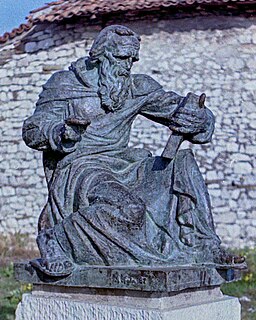
Onufri Argitis or Onoufrios of Neokastro or Onoufrios Argytes was a 16th century painter of Orthodox icons and Archpriest of Elbasan, active in the 16th century in modern-day southern Albania and in the south-western region of Macedonia. His works are characterized by post-Byzantine and Venetian influences. He also painted portraits, landscapes, and churches.
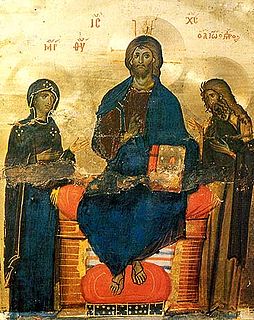
In Byzantine art, and in later Eastern Orthodox art generally, the Deësis or Deisis, is a traditional iconic representation of Christ in Majesty or Christ Pantocrator: enthroned, carrying a book, and flanked by the Virgin Mary and St. John the Baptist, and sometimes other saints and angels. Mary and John, and any other figures, are shown facing towards Christ with their hands raised in supplication on behalf of humanity.

The Byzantine Fresco Chapel is a part of the Menil Collection in Houston, Texas, near the University of St. Thomas. From February 1997 to February 2012, it displayed the only intact Byzantine frescoes of this size and importance in the entire western hemisphere. The Byzantine frescoes had been taken from the church of St. Evphemianos in Lysi, Cyprus in the 1980s. In September 2011, the collection announced that the frescos would be permanently returned to Cyprus in February 2012, following the conclusion of a long-term loan agreement with the Greek Orthodox Church of Cyprus. The frescoes had been presented at the museum by agreement with the Church of Cyprus, their owners, but the church decided not to extend the loan further. They will not return to their original home as Lysi is now in Northern Cyprus, but will be displayed at the Byzantine Museum in Nicosia. On March 4, 2012, the Byzantine Fresco Chapel closed, but re-opened in 2015 for the first in a series of site-specific projects.
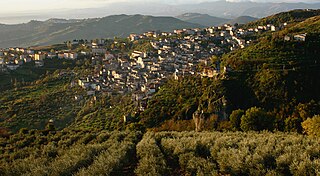
Lungro is a town and comune (municipality) in the Province of Cosenza in the Calabria region of Italy.

Hosios Loukas is a historic walled monastery situated near the town of Distomo, in Boeotia, Greece. It is one of the most important monuments of Middle Byzantine architecture and art, and has been listed on UNESCO's World Heritage Sites, along with the monasteries of Nea Moni and Daphnion.

A Hodegetria, or Virgin Hodegetria, is an iconographic depiction of the Theotokos holding the Child Jesus at her side while pointing to him as the source of salvation for humankind. The Virgin's head usually inclines towards the child, who raises his hand in a blessing gesture. In the Western Church this type of icon is sometimes called Our Lady of the Way.

The Church of Panagia Chalkeon is an 11th-century Byzantine church in the northern Greek city of Thessaloniki.
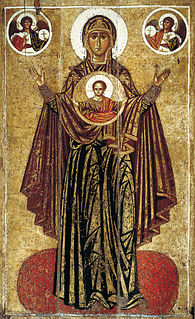
The Icon of Our Lady of the Sign is the term for a particular type of icon of the Theotokos, facing the viewer directly, depicted either full length or half, with her hands raised in the orans position, and with the image of the Child Jesus depicted within a round aureole upon her breast.

Lake Orestiada or Lake of Kastoria is a lake in the Kastoria regional unit of Macedonia, northwestern Greece. Sitting at an altitude of 630 metres, the lake covers an area of 28 square kilometres.
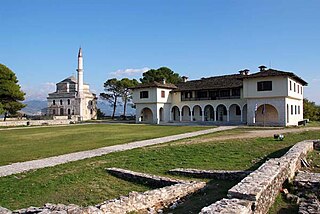
The Byzantine Museum of Ioannina is housed in one of the buildings of citadel of Ioannina, the capital of the Epirus region in northwestern Greece. The central section was built in the 1960s and originally functioned as a Royal Pavilion.
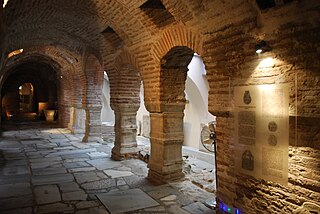
The city of Thessaloniki in Macedonia, Greece, for several centuries the second-most important city of the Byzantine Empire, played an important role for Christianity during the Middle Ages and was decorated by impressive buildings. In 1988, fifteen monuments of Thessaloniki were listed as UNESCO World Heritage Sites:
- City Walls
- Rotunda of Saint George
- Church of Acheiropoietos
- Church of St. Demetrios
- Latomou Monastery
- Church of St. Sophia
- Church of Panagia Chalkeon
- Church of St. Panteleimon
- Church of the Holy Apostles
- Church of St. Nicholas Orphanos
- Church of St. Catherine
- Church of Christ Saviour
- Blatades Monastery
- Church of Prophet Elijah
- Byzantine Bath
Onouphrios is a transliteration of the Greek Ονούφριος, originally from an Egyptian name, Christian name borne by Orthodox and Catholic Saints and notable people and may refer to:
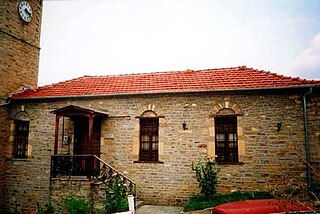
Lechovo is a historic village on the Kastoria–Amyndaio road, near the Kleissoura pass. In 1977, the Prophet Elijah Association of Lehovites started to collect artefacts of folk culture and ecclesiastical objects and to put together its folklore collection. Since 1980, the collection has been housed in a renovated historic building just off the main square, which is now the Lehovo Folklore Museum. The purpose of the museum is to preserve the traditions and the history of the village, which is why all the exhibits come from Lehovo itself.

The Serres Ecclesiastical Museum occupies the second floor of the Diocesan Headquarters in the town of Serres in northern Greece. It displays a collection of sacerdotal objects which come mainly from the local Monastery of St John the Baptist and from churches within the Metropolitanate of Serres and Nigrita.
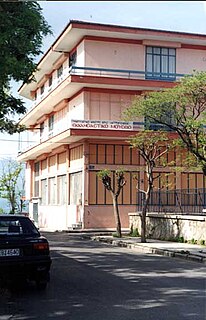
The Edessa Ecclesiastical Museum was founded in the northern Greek city of Edessa in 1996, by the local Diocese of Edessa, Pella, and Almopia. The museum is located on the outskirts of the traditional Varossi district and adjacent to Kokkinos Vrahos. It occupies the second floor of a three-storey building owned by the Diocese at 23 Megalou Alexandrou Street.

The Church of St. George is a 12th-century Macedonian Orthodox church located 2 km away from the village of Kurbinovo in North Macedonia. Excavations have shown that the building has once belonged to a settlement, which was abandoned at the end of the 18th century for the present-day village of Kurbinovo. According to the research made on the church's frescoes, it is supposed that the church was built in the year 1191 by the Byzantines. The church is a "monument of culture" in the Republic of North Macedonia and protected by law. It is also a part of the Prespa - Pelagonia diocese of the Macedonian Orthodox Church - Ohrid Archbishopric.

The Panagia Episkopi is the previous middle-Byzantine cathedral of the Greek Cycladean island of Santorini (Thira). It is also called Panagia tis Episkopis or Church of Episkopi Thiras. According to a traditional, now almost completely destroyed inscription, the church building was commissioned by the Byzantine Emperor Alexios I Komnenos at the end of the 11th century, and took the place of a previous three-aisled early Byzantine basilica. The church was dedicated to the Panagia ("All-holy"), a Greek Orthodox appellation for the Virgin Mary. The second part of the name (Episkopi) means "episcopal". The Panagia Episkopi was the seat of the Orthodox diocese of Santorini until 1207 and from 1537 to 1827.

The Monastery of Panagia Molyvdoskepastos is a male Greek Orthodox monastery at Molyvdoskepastos, near Konitsa, Epirus, in North Western Greece.























